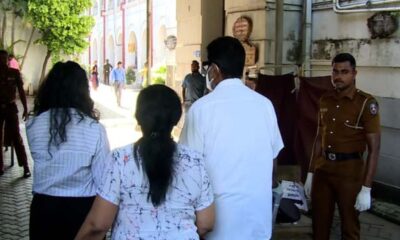FEATURES
Xi leads China’s reform, opening up in new era
Published
11 months agoon
By
editorIn December 2012, Xi Jinping, then newly elected general secretary of the Communist Party of China Central Committee, chose Guangdong, a frontier of China’s reform and opening up, as the destination of his first inspection tour.
During this trip, he issued a mobilization order to the whole Party and country.
“The decision to launch reform and opening up was right. We must keep to this correct path, ” he said. “We must stay unwavering on the road to the prosperity of the nation and the people.”
For over a decade, Xi has continuously planned the overall direction of reforms and promoted implementation.
2024 marks another significant year for deepening reform in the new era. Xi will lead the 1.4 billion Chinese people in jointly writing a new chapter of reform in the new era.
You may like
-
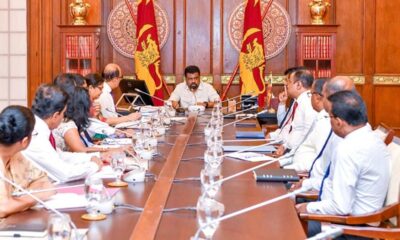

FDI records 90% increase in Q1 of 2025
-
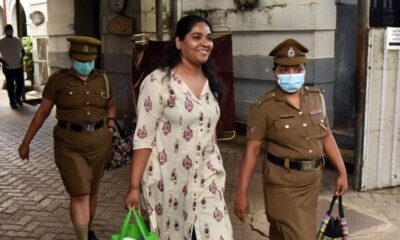

Keheliya’s daughter released after meeting bail conditions
-


NPP Chairman of Balangoda PS, resigns
-


85 Chinese nationals convicted of cybercrimes, deported from SL
-
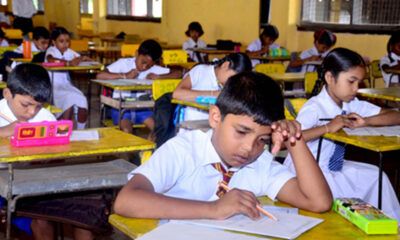

Gr. 5 scholarship exam to continue until 2029 – Dy. Minister
-


44 vehicles taken off the road over safety concerns
FEATURES
Adorable or just weird? How Labubu dolls conquered the world
Published
3 hours agoon
June 20, 2025By
editor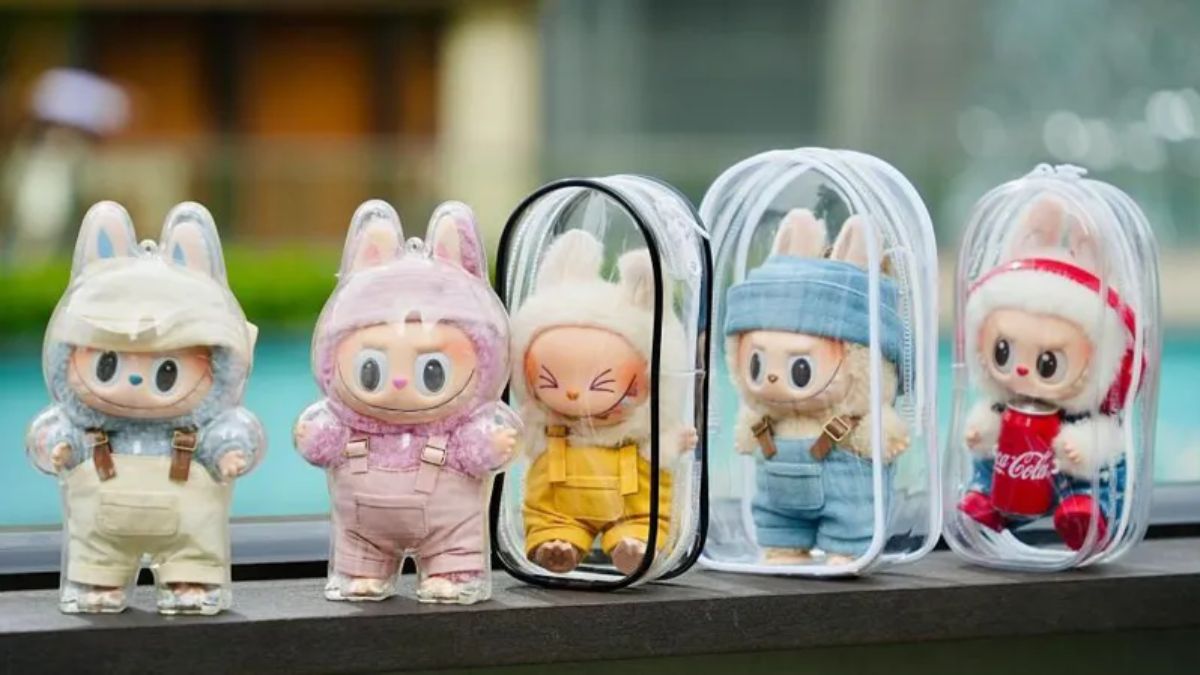
Whether you reckon they are cute, ugly or just plain weird, chances are you have heard of the furry dolls that have become a global sensation – Labubu.
Born a monster, the elf-like creature from Chinese toy maker Pop Mart is now a viral purchase. And it has no dearth of celebrity advocates: Rihanna, Dua Lipa, Kim Kardashian and Blackpink’s Lisa. Ordinary folk are just as obsessed – from Shanghai to London, the long queues to snap up the doll have made headlines, sometimes descending into fights even.
“You get such a sense of achievement when you are able to get it among such fierce competition,” says avowed fan Fiona Zhang.
The world’s fascination with Labubu has almost tripled Pop Mart’s profits in the past year – and, according to some, even energised Chinese soft power, which has been bruised by the pandemic and a strained relationship with the West.
So, how did we get here?
What exactly is Labubu?
It’s a question that still bothers many – and even those who know the answer are not entirely sure they can explain the craze.
Labubu is both a fictional character and a brand. The word itself doesn’t mean anything. It’s the name of a character in “The Monsters” toy series created by Hong Kong-born artist Kasing Lung.
The vinyl faces are attached to plush bodies, and come with a signature look – pointy ears, big eyes and a mischievous grin showing exactly nine teeth. A curious yet divided internet can’t seem to decide if they are adorable or bizarre.

The Labubu universe includes other characters that have inspired their own dolls
According to its retailer’s official website, Labubu is “kind-hearted and always wants to help, but often accidentally achieves the opposite”.
The Labubu dolls have appeared in several series of “The Monsters”, such as “Big into Energy”, “Have a Seat”, “Exciting Macaron” and “Fall in Wild”.
The Labubu brand also has other characters from its universe, which have inspired their own popular dolls – such as the tribe’s leader Zimomo, her boyfriend Tycoco and her friend Mokoko.
To the untrained eye, some of these dolls are hard to distinguish from one another. The connoisseurs would know but Labubu’s fame has certainly rubbed off, with other specimens in the family also flying off the shelves.
Who sells Labubu?
A major part of Pop Mart’s sales were so-called blind boxes – where customers only found out what they had bought when they opened the package – for some years when they tied up with Kasing Lung for the rights to Labubu.
That was 2019, nearly a decade after entrepreneur Wang Ning opened Pop Mart as a variety store, similar to a pound shop, in Beijing. When the blind boxes became a success, Pop Mart launched the first series in 2016, selling Molly dolls – child-like figurines created by Hong Kong artist Kenny Wong.

Pop Mart first opened as a variety store in Beijing in 2010
But it was the Labubu sales that fuelled Pop Mart’s growth and in December 2020, it began selling shares on the Hong Kong Stock Exchange. Those shares have soared by more than 500% in the last year.
Pop Mart itself has now become a major retailer. It operates more than 2,000 vending machines, or “roboshops”, around the world. And you can now buy Labubu dolls in stores, physical or virtual, in more than 30 countries, from the US and UK to Australia and Singapore, although many of them have recently paused sales due to overwhelming demand. Sales from outside mainland China contributed to nearly 40% of its total revenue in 2024.
In a sign of just how popular Labubus have become, Chinese customs officials said this week that they had seized more than 70,000 fake dolls in recent days.
The demand did not rise overnight though. It actually took a few years for the elfin monsters to break into the mainstream.
How did Labubu go global?
Before the world discovered Labubu, their fame was limited to China. They started to become a hit just as the country emerged from the pandemic in late 2022, according to Ashley Dudarenok, founder of China-focused research firm ChoZan.
“Post-pandemic, a lot of people in China felt that they wanted to emotionally escape… and Labubu was a very charming but chaotic character,” she says. “It embodied that anti-perfectionism.”
The Chinese internet, which is huge and competitive, produces plenty of viral trends that don’t go global. But this one did and its popularity quickly spread to neighbouring South East Asia.
Fiona, who lives in Canada, says she first heard about Labubu from Filipino friends in 2023. That’s when she started buying them – she says she finds them cute, but their increasing popularity is a major draw: “The more popular it gets the more I want it.
“My husband doesn’t understand why me, someone in their 30s, would be so fixated on something like this, like caring about which colour to get.”

Labubu pendants are the most coveted
It helps that it’s also affordable, she adds. Although surging demand has pushed up prices on the second-hand market, Fiona says the original price, which ranged from 25 Canadian dollars ($18; £14) to 70 Canadian dollars for most Labubu dolls, was “acceptable” to most people she knows.
“That’s pretty much how much a bag accessory would cost anyway these days, most people would be able to afford it,” she says.
Labubu’s popularity soared in April 2024, when Thai-born K-pop superstar Lisa began posting photos on Instagram with various Labubu dolls. And then, other global celebrities turned the dolls into an international phenomenon this year.
Singer Rihanna was photographed with a Labubu toy clipped to her Louis Vuitton bag in February. Influencer Kim Kardashian shared her collection of 10 Labubu dolls with her Instagram following in April. And in May, former England football captain Sir David Beckham also took to Instagram with a photo of a Labubu, given to him by his daughter.
Now the dolls feel ubiquitous, regularly spotted not just online but also on friends, colleagues or passers-by.
What’s behind the Labubu obsession?
Put simply, we don’t know. Like most viral trends, Labubu’s appeal is hard to explain – the result of timing, taste and the randomness that is the internet.
Beijing is certainly happy with the outcome. State news agency Xinhua says Labubu “shows the appeal of Chinese creativity, quality and culture in a language the world can understand”, while giving everyone the chance to see “cool China”.
Xinhua has other examples that show “Chinese cultural IP is going global”: the video game Black Myth: Wukong and the hit animated film Nezha.

A Pop Mart store in Shanghai
Some analysts seem surprised that Chinese companies – from EV makers and AI developers to retailers – are so successful despite Western unease over Beijing’s ambitions.
“BYD, DeepSeek, all of these companies have one very interesting thing in common, including Labubu,” Chris Pereira, founder and chief executive of consultancy firm iMpact, told BBC News.
“They’re so good that no one cares they’re from China. You can’t ignore them.”
Meanwhile, Labubu continue to rack up social media followers with millions watching new owners unbox their prized purchase. One of the most popular videos, posted in December, shows curious US airport security staff huddling around a traveller’s unopened Labubu box to figure out which doll is inside.
That element of surprise is a big part of the appeal, says Desmond Tan, a longtime collector, as he walks around a Pop Mart store in Singapore vigorously shaking blind boxes before deciding which one to buy. This is a common sight in Pop Mart.
Desmond collects “chaser” characters, special editions from Pop Mart’s various toy series, which include Labubu. On average, Desmond says, he finds a chaser in one out of every 10 boxes he buys. It’s a good strike rate, he claims, compared to the typical odds: one in 100.
“Being able to get the chaser from shaking the box, learning how to feel the difference…,” is deeply satisfying for him.
“If I can get it in just one or two tries, I’m very happy!”
– Fan Wang, Adam Hancock
(BBC News)


Remember listening to a young lady TV Anchor in a private TV channel a few months ago, demanding from an Opposition MP, what threats he is referring to as “threats to national security”. On her own definition, she was quite certain there are “no threats to national security” as claimed by the Opposition. “Its past midnight when I go home…. after these programmes” she said on camera. “I have never felt any threat to me” she added. The opposition argument was, heavy increase in “shootings” during the past few months in most parts of the country and an increase in deaths due to such shootings, would bring about a threat to “National Security” if not controlled immediately.
But what is “National Security?”
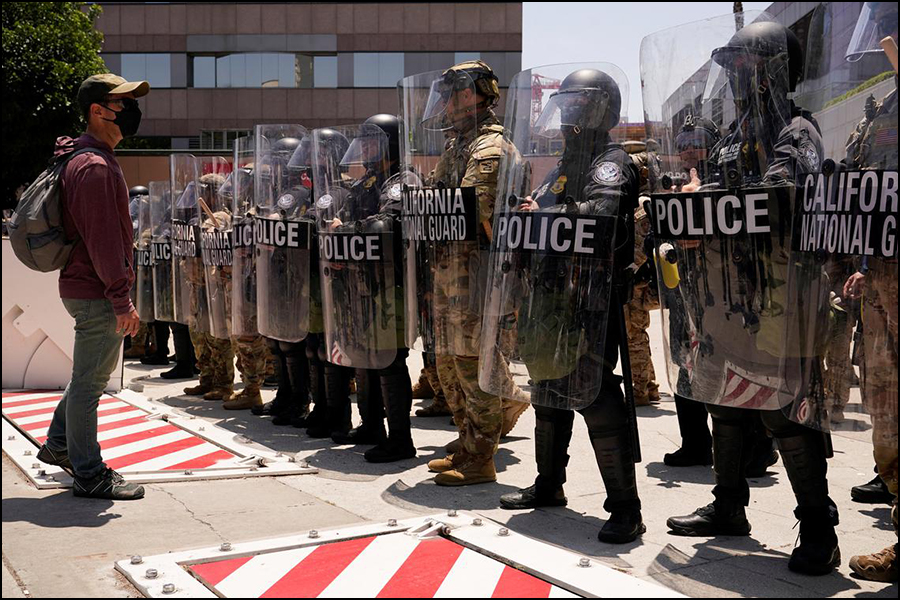
The concept of “national security” evolved over many decades ago with assumed “external threats” to a nation and its people. During the past two plus decades, especially after the New York 9/11 terrorist attack, the concept of national security has been broadened beyond “nations” with intensive intelligence gathering networks. Ethnic and religious conflicts, border clashes and environmental degradation have been added since. The most recent Indo-Pak armed conflict, is one that is spoken of as a “national threat” to India among “Shiv Sena and Hindutva” groups.
We in Sri Lanka, did have remotely manipulated threats to our national security, first in early 1980’s when Indira Gandhi was Prime Minister in neighbouring India. Her perception of Jayawardene presidency as heavily weighted towards US, was what compelled her to intervene in our politics. In his book “Assignment Colombo” the Indian High Commissioner in Colombo J.N. Dixit wrote, “The first step that Mrs. Gandhi took was to give support to Sri Lankan Tamil parties and Tamil militant groups from 1980 onwards, details of which have been mentioned in a number of articles and books over the last 09 years. There is no need for me to repeat them”. (p/15)
As said, details given in many other writings confirm PM Indira Gandhi provided Sri Lankan armed Tamil groups with funds, military training and arms. In 1997, visiting Dehradun that borders Himalayas, I had a wholly unexpected meeting with a social activist very close to the Gandhi family. He took me to the “Rashtriya Indian Military College” in Garhi Cantt, where a select group of LTTE cadres had been trained to use “RPGs” and mortars. I was shown a massive rock in the hills, not too far away from the military college and told, mortars were fired at that rock during training.
Then Tamil Nadu (TN) Chief Minister, Sri Lankan born M.G. Ramachandran, popularly known in Tamil cinema as MGR, provided special accommodation to most Tamil armed group leaders and is said to have funded the LTTE nurturing a special fancy towards Prabhakaran. All that certainly was collective Indian manipulations in undermining our national security.

The next came in 1987 June. Then State Minister of Defence Lalith Athulathmudali a hardliner in Indo-Sri Lanka relations, endorsed a military offensive in March 1987 to take over Jaffna peninsula. Towards end May, the state military entered Jaffna peninsula and was pushing the LTTE towards Wadamarachchi. New Delhi hastened to inform the Colombo government, they want the “Wadamarachchi offensive” stopped immediately, to avoid a situation of mass hunger in the peninsula. Food not used as a “weapon of war”, Athulathmudali was determined to take-over whole of Jaffna peninsula in less than 02 weeks and was in no mood to halt the military offensive.
Yet Tamil Nadu convinced PM Rajiv Gandhi to decide on a flotilla of naval boats to deliver food to Jaffna. When Sri Lankan navy stopped them from entering SL waters and forced them to return to Rameswaran on June 03, India had decided on the ill-famed “air drop” on Jaffna, violating Sri Lankan airspace. On 04 June the airdrop of food parcels was carried out with SL High Commissioner in New Delhi Bernard Thilakaratne informed of the air drop about an hour before. Next day the Indian media carried the news of Indian Air force “successfully” completing “Operation Poomalai” by dropping food parcels on Jaffna that brought the Wadamarachchi offensive to a stop.
The last such threat on Sri Lankan national security was when PM Rajiv Gandhi in July 1987 almost coerced President Jayawardene to accept his government’s answer to the Sri Lankan Tamil armed conflict. The Indo-Sri Lanka Accord was signed in Colombo in July 1987 that led to Indian Peace Keeping Forces (IPKF) taking over security of North-East and formation of elected Provincial Councils with devolved power. In Sinhala South, opposing the PCs and the IPKF presence, the JVP unleashed a terror campaign leading to complete mayhem.
All that being history, since President Rajapaksa declared the war as “victoriously concluded” on 19 May, 2009 with the LTTE and its entire leadership eliminated, Modi’s India has become a strong ally of Sri Lanka in its efforts to tide over the recent economic crisis. There remained no other external factor that can be assumed as an imminent threat to Sri Lanka’s national security.
What then is the Opposition assuming as a possible threat to our national security with increased shootings and deaths during the past few months? Unless these underworld groups are bought over by an “external agency” in the future, for now, they are only a threat to social stability and peace, and not “national security”. They act on their own agenda, nevertheless creating an uncertainty about citizen’s safety and security to life. It is therefore about how efficient the government is, in policing society, ensuring law and order for all and one.
NPP Foreign Policy & Genocide
If at all, what could in the future be a threat to our national security is the present NPP government’s pro-US foreign policy that accommodates Israel as a “peaceful” non-aggressive State, ignoring the genocidal war against Palestine. But on the ground, with mass recruitments of Israeli youth for the ongoing military offensives against Palestine since October 2023, Israeli government needs labour for their community based farming and for quick reconstruction of damaged buildings due to Hamas rocket fire.
Since Gotabhaya Rajapaksa as Secretary to the Ministry of Defence opened up links for Sri Lankan migrant employment in Israel, 02 MoUs signed between the two governments have in 2020 provided jobs for home stay female caregivers and again in 2023 for agriculture labour, subsequently extended for construction work as well. This year during the first 03 months, nearly 2,000 Sri Lankans have left to Israel as construction workers. In mid May this year, another 447 Sri Lankans were ready to leave according to Sri Lanka Bureau of Foreign Employment (SLBFE). (https://www.slbfe.lk/slbfe-news/447-sri-lankans-to-begin-employment-in-israels-construction-sector/)
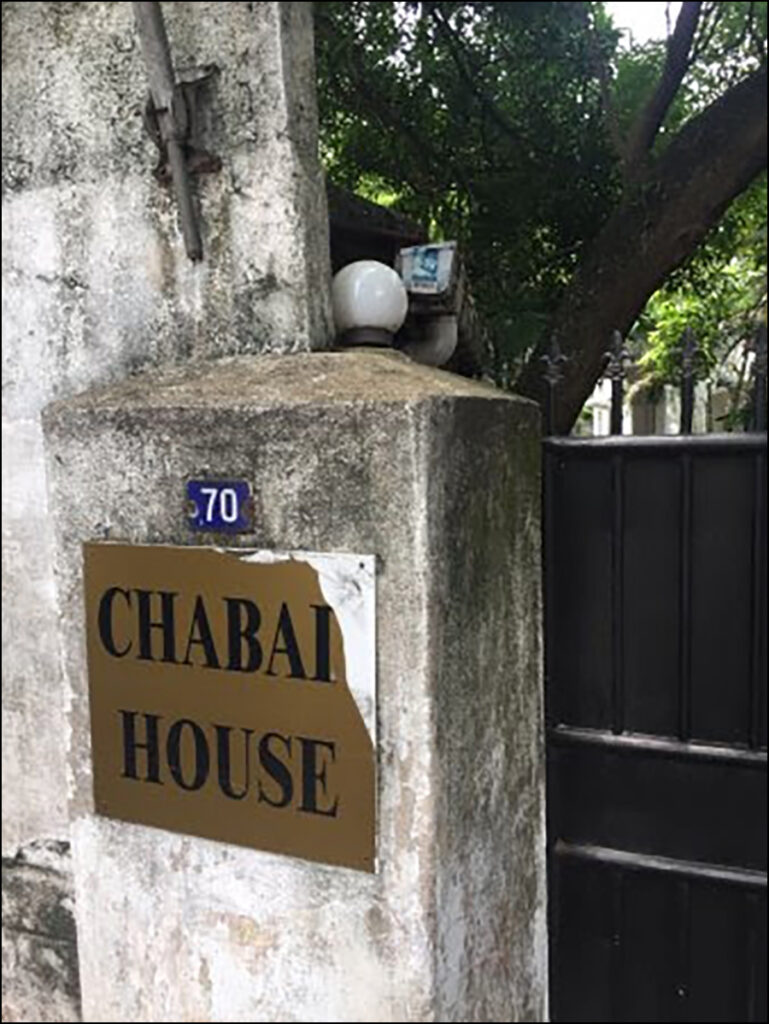
Added is the space provided by this NPP government for Israeli “tourists” to basically live here in Sri Lanka, with their own abodes and establishing cultural centres called “Chabad Houses”. It is rather puzzling how the NPP government could allow Israeli “tourists” to establish their cultural centres the government too accept as illegal, while providing armed police security for their safety. Presumably after a protest on the opposite pavement in front of the Chabad House in Kollupitiya on 09 May, a hurried announcement made by the Police Media Division on 11 May (2025) says, Israelis staying in Sri Lanka who have established Chabad Houses in some police divisions for their convenience, have been provided adequate security by those police divisions, due to threats to Chabad Houses. The police media division also says, if any foreign nationals staying in Sri Lanka needs security, SL Police would provide adequate security after an assessment on threats.
This NPP government’s foreign policy that officially provides SL labour for warring Israel and allows Israelis to “stay” in Sri Laka with State security, may in the future open Sri Lanka for “external” anti-Israeli threats as was discussed in many social forums over alleged ISIS links during the 2019 April Easter Sunday attacks that left 253 fatalities.
This possibility of destabilising Sri Lanka by external anti-Israeli agents, can only be counted by a principled change in foreign policy of the NPP government. With strong US support to stay within the IMF programme and with no alternate thinking, this government’s foreign policy can only be positively changed by rational social interventions by the Opposition that to date is totally absent. Sadly in Colombo, even the generally accepted educated, professional middleclass perception is wholly flawed. They claim they oppose genocide and stand in solidarity with Palestine, but have no demands for this NPP government to honour at least a viable ceasefire. No demand the NPP government should stop providing SL labour to Israel, heavily engaged in a brutal a war that to date has left over 55,000 Palestinians killed counting around 70 percent children and women, 180 journalists and over 224 humanitarian aid workers including 179 that worked for UN Relief and Works Agency (UNRWA).
If dollar remittances are all what matters to the NPP government, this NPP foreign policy of accommodating Israel, whose PM Benjamin Netanyahu and his former Defence Minister Yoav Gallant have arrest warrants issued by the International Criminal Court (ICC) for war crimes and crimes against humanity in Gaza, may invite threats to our national security, neither the NPP government nor the Opposition is willing to pay attention to.
– Kusal Perera
FEATURES
Indian scientists search for the perfect apple
Published
7 days agoon
June 13, 2025By
editor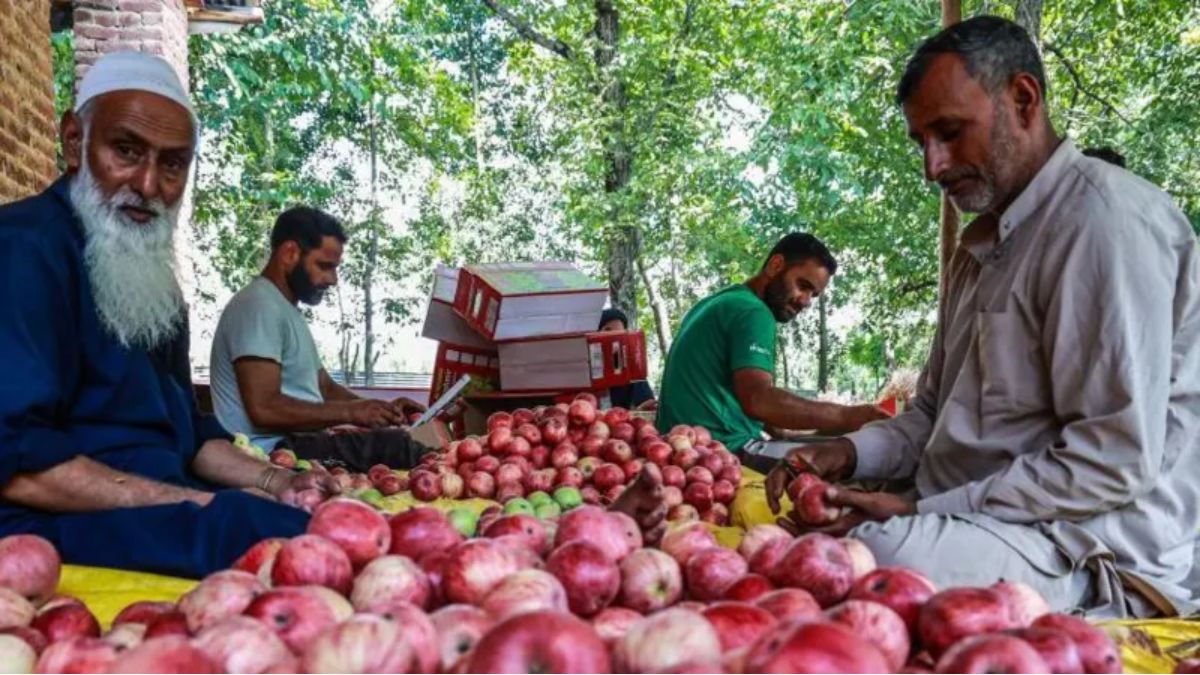
Jammu and Kashmir is India’s biggest apple producing region
“My neighbours thought I’d lost my mind,” says farmer Kakasaheb Sawant.
In 2022 he had decided to plant some apple trees, not crazy for a farmer unless, like Mr Sawant, you live in subtropical southern India, where temperatures can hit 43C.
He bought 100 saplings, of which 80 survived. Last year each tree produced between 30 and 40 kilogrammes of fruit.
“My farm has become something of a local miracle. People travel from far-off places just to see the apple trees growing under the hot Maharashtra sun.”
It’s not been an unqualified success though. One problem is that the apples are not sweet enough to sell.
Mr Sawant remains enthusiastic. He’s had some success selling apple tree saplings and is optimistic about future harvests.
“This is the beginning. The trees are getting acclimatised so according to me in next four to five years these trees will start bearing good, sweet apples.”
In his own small way, Mr Sawant is hoping to meet India’s rising demand for apples.
Production has risen 15% over the last five years to 2.5 million tonnes.
But that is not keeping up with demand and India’s imports have roughly doubled to 600,000 tonnes over the same period, according to S Chandrashekhar, who analyses India’s apple trade.
“We do have a shortage of apple production,” he says. “There are not many new players… at the same time, and there is no new investment.”
Essential for a good apple crop is a lengthy period of winter temperature between 0C and 6C.
Countries like the UK, with around 1,000 hours of this chill-time, can produce almost any apple variety.
But in India areas with those conditions are more limited.
Most of India’s apples come from two regions in the north of the country -Jammu and Kashmir and neighbouring Himachal Pradesh.
Mr Chandrashekhar says that many farms in those regions are becoming less productive.
“There are lot of old orchards producing fewer apples – that means the yield is coming down,” he says.
He says that climate change is making conditions less favourable.

Researches have grown apples in subtropical Ranchi, eastern India
In the hope of expanding apple production into new areas, some scientists and farmers are experimenting with so-called low-chill varieties.
Those are apple trees that can produce crops with around 400 hours of temperatures between 0C and 6C.
Ranchi, eastern India is also not an apple growing region – its subtropical climate is too hot.
But researchers at the Birsa Agricultural University (BAU) are testing 18 saplings of three low-chill varieties.
Success has been limited so far – only one of the varieties has produced any fruit.
“The plants have not reached optimal sizes. The tree has given us only around one to two kilogrammes of apples in 2024. I would not say that they are of best quality, but they were edible,” says Dr Majid Ali.
He says that as well as an unfavourable climate, the local soil is not ideal for apple trees and the trees get attacked by termites.
“This is an experimental stage. To reach a conclusion it would take three to four years to say if it is successful.”
He says that some local farmers have also been experimenting with low-chill apple varieties, also with little success.

India’s apple growers are struggling to keep up with demand
Some are sceptical that apples cultivated in hot areas will ever be a commercial proposition.
“The fruit that grows in non-traditional regions has a very short shelf life. The taste is not so sweet,” says Dr Dinesh Thakur, associate director of a regional horticulture research and training centre at Dr YS Parmar University of Horticulture and Forestry.
“These low-chill apples can be grown as novelty fruit in a kitchen garden, but their viability as a commercial crop is not proven… most of them are a failure,” he says.
Dr Thakur is based in the traditional northern apple growing region of Himachal Pradesh and his research focuses on the improvement of apples through breeding.
“Climatic change is creating havoc in apple cultivation,” he says.
He says the number of those crucial chilling hours are falling and due to erratic weather conditions farmers are facing colossal financial losses every year.
In search of better conditions, some orchards are being planted in higher locations, which were once considered too cold, he says.
Under a government sponsored project his team are experimenting with 300 varieties of apples, to assess the impact of climate change.
“We are also working on climate-resilient apple genotypes that can withstand the existing climate,” he says.
So far, they have developed an apple that matures with a ripe colour two months earlier than existing apple trees.
“This helps offset erratic weather patterns brought by climate change and has a quality advantage over those areas where colour formation is problem due to lack of sunlight,” Dr Thakur says.
“This is just the beginning of research to create climate resilient fruit and create a fruit that is acceptable to the Indian taste bud.”
For Mr Chandrashekhar, boosting India’s apple output will take more than just scientific work.
“Apple orchards in the traditional apple cultivation areas are 15 to 20 years old. What is needed is replanting of new saplings,” he says.
“The industry needs investment, huge investment. Who will do that?” he asks.
He would like to see the juice and jam business developed, to provide the industry with another source of income.
“That has to be a booster which can improve the apple economy and provide a better position for apple growers.”
– Priti Gupta
(BBC News)

FDI records 90% increase in Q1 of 2025

Keheliya’s daughter released after meeting bail conditions








